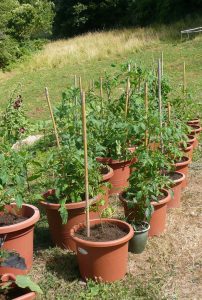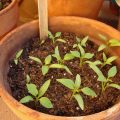 It can be tempting to grow a little bit of everything – so tempting that you’ll eventually run out of space in your garden. When this happens, you can either expand to the side yard or front yard (we’re joking) or begin a container garden (not joking). Container gardens are more than useful spaces to grow herbs – as long as the pot is big enough, plenty of vegetables can be planted in them as well.
It can be tempting to grow a little bit of everything – so tempting that you’ll eventually run out of space in your garden. When this happens, you can either expand to the side yard or front yard (we’re joking) or begin a container garden (not joking). Container gardens are more than useful spaces to grow herbs – as long as the pot is big enough, plenty of vegetables can be planted in them as well.
Choose Your Plants, Then Your Pots – Or Vice Versa
The beauty of container gardening is the fact that it is simple to set up. You can either go with a series of containers or pots that you already have, choosing plants that will fit into them, or buy your plants first, then your pots. The trick is to ensure that you have enough space for them. For example, if you live in an apartment, then you definitely have to work within your space constraints. But, if you already have a backyard garden, you can place your containers on your patio, back deck, or around your vegetable beds. There is a lot of flexibility there.
Plants That Work Well In Containers
As long as your containers are big enough, you can grow just about anything, depending on your climate. However, some crops, like corn, for example, won’t grow in a container. (Feel free to try, though!) We suggest planting an array of lettuces, peppers, tomatoes, eggplant, squash, and zucchini in your container garden, plus the always-popular herbs. Just keep in mind that some of our suggested crops, like the zucchini and squash, need space to spread out horizontally, while others, like the peppers and tomatoes, will grow vertically and may need a trellis near their containers.
Soil and Watering Solutions
You cannot simply take soil from your backyard garden and plop it into a container. This soil might bring in pests and diseases that will effect the growing environment in the container. Since the containers won’t provide the plant’s roots with the right nutrients, you need to use a potting mix. Avoid those labeled as compost or bagged topsoil, since they won’t be light enough – over time they will compact, compressing the root systems in the process. Instead, look for a light and fluffy type of potting soil, one that preferably contains peat moss, perlite, vermiculite, lime and/or aged bark. These types of potting soil come out of the bag damp, and fluffy enough to not compact in the container.
Another problem involves watering. You’ll need to water your container garden daily, while making sure that the soil drains properly as the same time. Because of this, you shouldn’t use containers without drainage holes in the bottom. If these holes aren’t there, the water will pool in the bottom of the containers, creating a damp environment where the roots will begin to rot, killing the plants.
As long as the right conditions are created and the plants fit their pots, feel free to experiment with your container garden. You might find it easier to grow vegetables in them than in the actual ground!
Pic by cristina.sanvito




No comments yet.